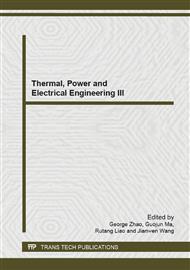p.595
p.599
p.603
p.609
p.614
p.621
p.625
p.631
p.635
Experimental Research on Heat Transfer of Closed Cooling Tower with Packing
Abstract:
Three different structural types of closed cooling tower (CCT) and two cooling water flow directions were considered. The experimental study were done on the cooling performance of influences of inlet air dry and wet bulb temperature, cooling water flow rate and inlet temperature, air flow rate and spray density. The experimental results show that the cooling performance of CCT with packing is obviously better than non-packing cooling tower in 7%~18.4%. And the cooling performance of CCT with packing on top and coil underneath is slightly better than CCT with coil on top and packing underneath in 4.9%. In the same conditions the cooling performance of CCT with packing under cooling water cocurrent-flow is better than that cooling water countercurrent-flow in 3.2%~9.6%. Therefore, the closed cooling tower structure with the cooling water path in bottom and out top, and with packing on top and coil underneath is recommended.
Info:
Periodical:
Pages:
614-620
Citation:
Online since:
June 2014
Authors:
Keywords:
Price:
Сopyright:
© 2014 Trans Tech Publications Ltd. All Rights Reserved
Share:
Citation:


